Autocad Drawing Wont Export to Pdf
Exporting or Printing Your LayOut Document
After you work hard to create and polish a LayOut document, you want your document to go out into the world and make its mark. You can present your work on-screen, but that isn't always enough. Here are other ways you can share your document:
- Upload a document online or attach it to an email. You can export your document pages as JPEG or PNG image files that you can display on web pages. Or you can make a PDF that your audience can download from the web or as an email attachment.
- Open a document in a CAD program. You can also export your LayOut document to a DWG or DXF file, either of which is compatible with popular CAD programs.
- Print your document. Whether you need a high-quality print or just printouts of your pages for your audience to take notes, LayOut includes printing options to help you create just the printout you need.
Tip: Before you export or print a document, check your Paper settings in the Document Setup dialog box. With these settings, you can choose whether to export or print a background color or transparent background. You can also select whether to export or print margin lines and select the quality for image or SketchUp model entity rendering (Low, Medium, or High). For details, see Creating and Saving a LayOut Document.
Table of Contents
- Exporting a document as image files
- Creating a PDF of your document
- Exporting a document to DWG or DXF format
- Printing your document
Exporting a document as image files
When you export a document as a series of images, LayOut exports each document page as a separate image file, in either .jpg or .png format. The following steps, which reflect the selected operating system, walk you through the image-export process:
- From the menu bar, select File > Export > Images. The Export Images dialog box appears, as shown in the following figure.
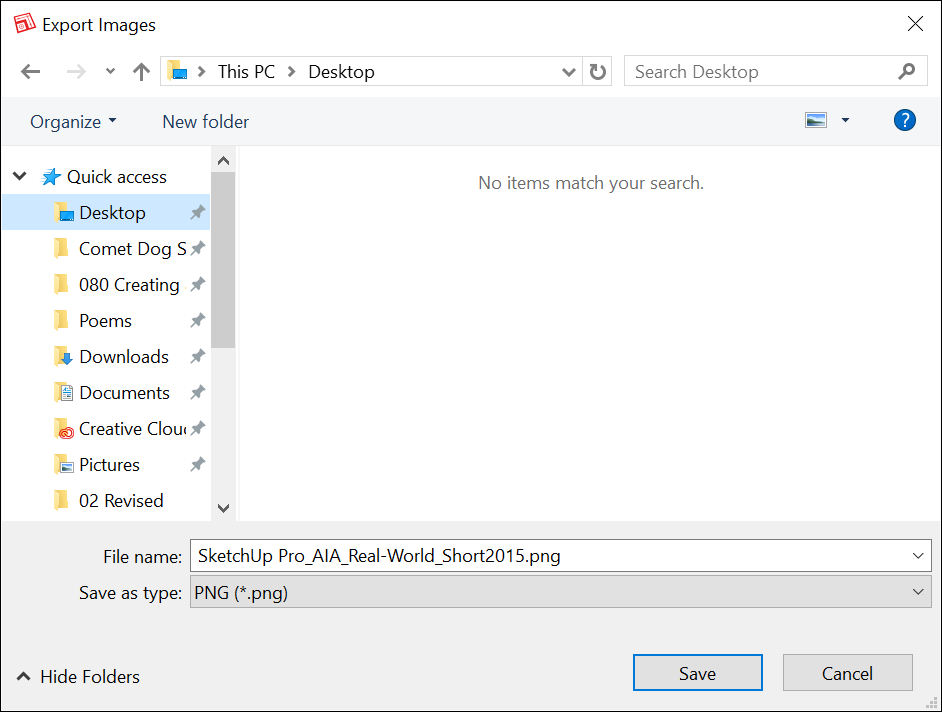
- Navigate to the location where you want to save your images.
- In the File Name box, type a name that will begin each image file you export. If you export multiple images, LayOut exports a number to each image in the series, such as
Green Vale Homes_1.png,Green Vale Homes_2.png, and so on. - From the Save As Type drop-down list, select PNG or JPEG.
- Click the Save button. The Image Export Options dialog box appears.
- (Optional) In the Pages area, select whether you want to export all the document pages (the default) or just a page range. To print a page range, select the From/To radio button and enter the page range that you want to export.
- (Optional) To change the size and resolution of your exported images, enter a new width or height value or type your desired resolution. These three settings are constrained so, for example, changing the width automatically adjusts the height to maintain the image's aspect ratio.
- (Optional) By default, your exported images open in your default image viewer. Deselect the Show Export in Image Viewer checkbox if you don't want to open the images in this program.
- Click the Export button. The images are exported to the location you selected in Step 2.
- From the menu bar, select File > Export. An export dialog box appears, as shown in the following figure.
- In the Save As box, type a name that will begin each image file you export. If you export multiple images, LayOut exports a number to each image in the series, such as
Green Vale Homes_1.png,Green Vale Homes_2.png, and so on. - Navigate to the location where you want to save your images.
- From the Format drop-down list, select PNG or JPG.
- Click the Options button. The Image Export Options dialog box appears.
- (Optional) In the Pages area, select whether you want to export all the document pages (the default) or just a page range. To print a page range, select the From/To radio button and enter the page range that you want to export.
- (Optional) To change the size and resolution of your exported images, enter a new width or height value or type your desired resolution. These three settings are constrained so, for example, changing the width automatically adjusts the height to maintain the image's aspect ratio.
- (Optional) By default, your exported images open in your default image viewer. Deselect the Show Export in Image Viewer checkbox if you don't want to open the images in this program.
- Click the OK button.
- Back in the export dialog box, click the Save button. The images are exported to the location you selected in Step 3.

Creating a PDF of your document
When you export a PDF of a document, LayOut creates a single PDF file that contains your document pages. To export your document as a PDF, follow these steps, which reflect the selected operating system:
- From the menu bar, select File > Export > PDF. The Export PDF dialog box appears, and the PDF format is already selected in the Save As Type drop-down list.
- Navigate to the location where you want to save the PDF.
- In the File Name box, type a name for the file.
- Click the Save button. The PDF Export Options dialog box appears, as shown in the following figure.
- (Optional) The location and filename in the Export File field reflect the location you chose in Step 2. If you change your mind, click the Choose button and select a new location.
- (Optional) By default, LayOut includes all the pages in your document in the PDF. To specify a page range instead, select the From/To radio button and type the page numbers for your desired page range.
- (Optional) To change the quality for rendering models and images in your exported PDF, select an option from the Output Quality Output Resolution drop-down list.
- (Optional) A great way to reduce the file size of the resulting PDF is to compress images in your LayOut document. Select the Use JPEG Compression for Images option and move the slider to Smaller File to reduce the quality of the images and reduce the file size as well. For a higher quality image, however, move the quality slider to Better Quality.
- (Optional) By default, LayOut creates a PDF layer that corresponds to each layer in your document. If you don't want LayOut to create these layers, deselect the Create PDF Layers from LayOut Layers checkbox.
- (Optional) By default, LayOut displays the exported PDF file in your system's PDF viewer, such as Adobe Reader. If you don't want LayOut to open the file for you, deselect the Show Export in PDF Viewer checkbox.
- Click Export, and LayOut creates the PDF in the location you specified in Step 2.
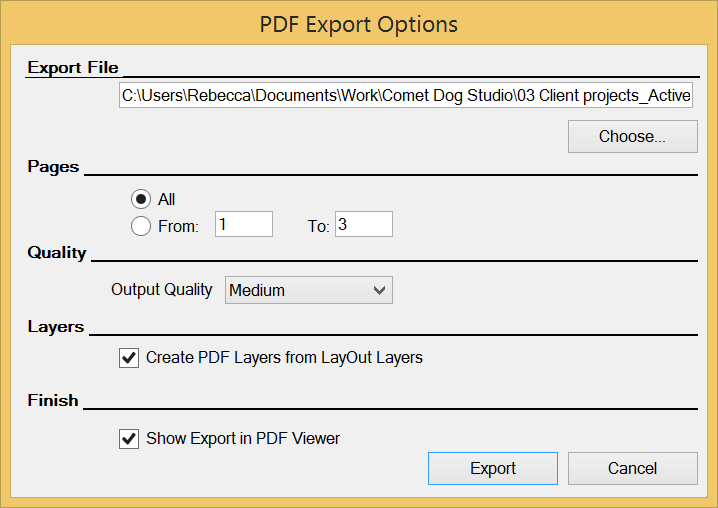

- From the menu bar, select File > Export. An export dialog box appears.
- In the Save As box, type a name for the PDF file.
- Navigate to the location where you want to save your images.
- From the Format drop-down list, select PDF.
- Click the Options button. The PDF Export Options dialog box appears, as shown in the following figure.
- (Optional) In the Pages area, select whether you want to export all the document pages (the default) or just a page range. To print a page range, select the From/To radio button and enter the page range that you want to export.
- (Optional) To change the quality for rendering models and images in your exported PDF, select an option from the Output Quality Output Resolution drop-down list.
- (Optional) A great way to reduce the file size of the resulting PDF is to compress images in your LayOut document. Select the Use JPEG Compression for Images option and move the slider to Smaller File to reduce the quality of the images and reduce the file size as well. For a higher quality image, however, move the quality slider to Better Quality.
- (Optional) By default, your exported images open in your default image viewer. Deselect the Show Export in PDF Viewer checkbox if you don't want to open the images in this program.
- Click the OK button.
- Back in the export dialog box, click the Save button. The images are exported to the location you selected in Step 3.
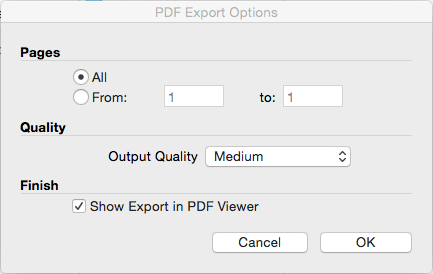
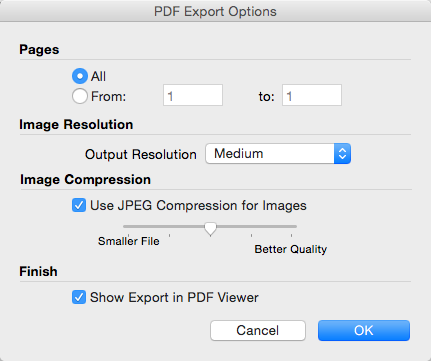
Exporting a document to DWG or DXF format
DWG and DXF are file formats that open in popular CAD programs. To export a document to one of these formats, follow these steps, which reflect your selected operating system:
Tip: If a layer is hidden on all pages, the layer is exported as hidden. If the layer is hidden on some but not all pages, only the visible entities are exported. Tip: LayOut 2017 improves entity export compared to previous versions, exporting dimensions, labels, circles, arcs, ellipses, and tables as native DWG/DXF entities. Note: LayOut entities are exported into paper space. SketchUp model entities (except models in Perspective view) are exported into model space. Tip: If a layer is hidden on all pages, the layer is exported as hidden. If the layer is hidden on some but not all pages, only the visible entities are exported. Tip: LayOut exports dimensions, labels, circles, arcs, ellipses, and tables as native DWG/DXF entities. Note: LayOut entities are exported into paper space. SketchUp model entities (except models in Perspective view) are exported into model space. Tip: The 'Export for SketchUp' feature places all LayOut entities into the Model Space so that SketchUp can now 'play' with all LayOut data. As part of this feature Groups are sent over as SketchUp Components, Fills and Patterns are sent over as SketchUp faces for easy Push/Pull'n. Note: LayOut entities are exported into paper space. SketchUp model entities (except models in Perspective view) are exported into model space.
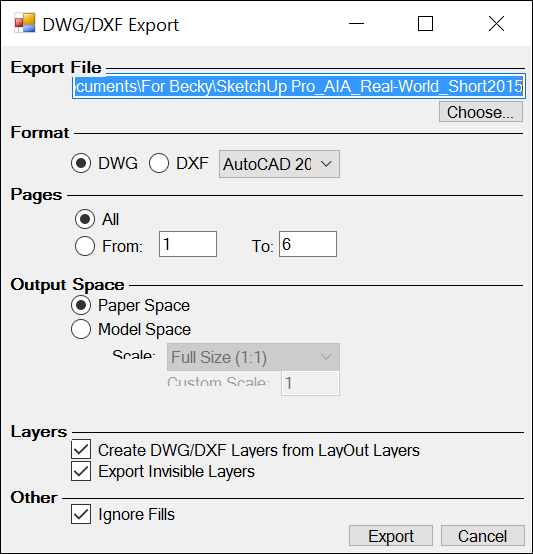

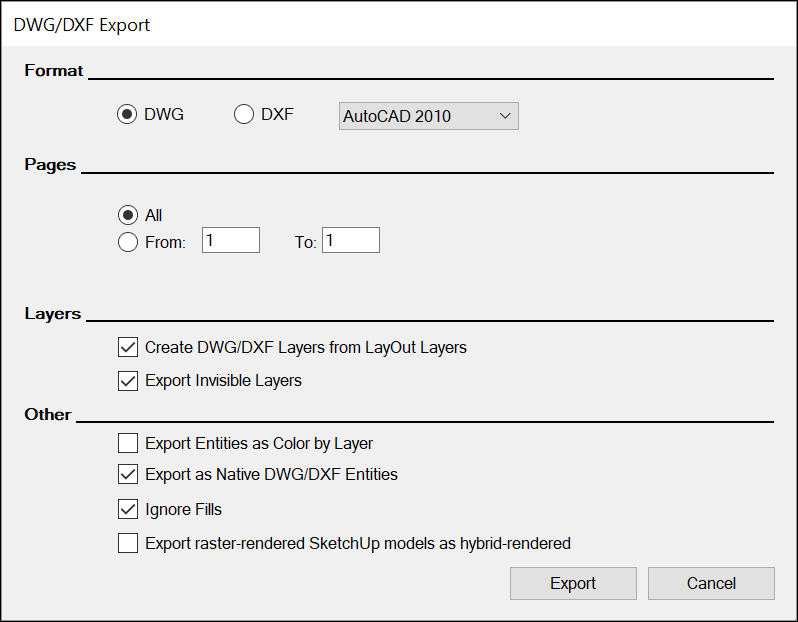

Tip: If a layer is hidden on all pages, the layer is exported as hidden. If the layer is hidden on some but not all pages, only the visible entities are exported. Tip: LayOut exports dimensions, labels, circles, arcs, ellipses, and tables as native DWG/DXF entities. Note: LayOut entities are exported into paper space. SketchUp model entities (except models in Perspective view) are exported into model space. Tip: The 'Export for SketchUp' feature places all LayOut entities into the Model Space so that SketchUp can now 'play' with all LayOut data. As part of this feature Groups are sent over as SketchUp Components, Fills and Patterns are sent over as SketchUp faces for easy Push/Pull'n. Note: LayOut entities are exported into paper space. SketchUp model entities (except models in Perspective view) are exported into model space.
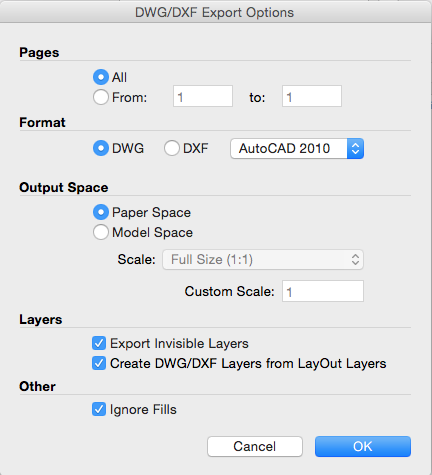


Printing your document
The great German philosopher, Friedrich Nietzsche, once said, "Print is dead." Or something like that. (Beware the accuracy of quotes you find on the Internet.) Regardless, people stopped heralding the advent of the paperless office years ago. Printouts still have a place and a purpose in this world. If you have such a purpose for your LayOut document, this section guides you through the printing process.
Whether you use LayOut for Microsoft Windows or Mac OS X, the basic printing process is the same:
- Select File > Page Setup to check your page setup options.
- Preview your printout.
- Select File > Print to select your final print options and send your presentation to the printer.
However, the specific steps vary between Microsoft Windows and Mac OS X. In the following steps, you walk through the whole detailed printing process for the selected operating system:
- From the menu bar, select File > Page Setup. The Page Setup dialog box appears.
- From the Size drop-down menu, select a paper size.
- From the Source drop-down menu, select the printer tray that contains the paper you want to use.
- Click OK in the Page Setup dialog box.
- Select File > Print Preview to open the Print Preview dialog box, shown in the following figure.
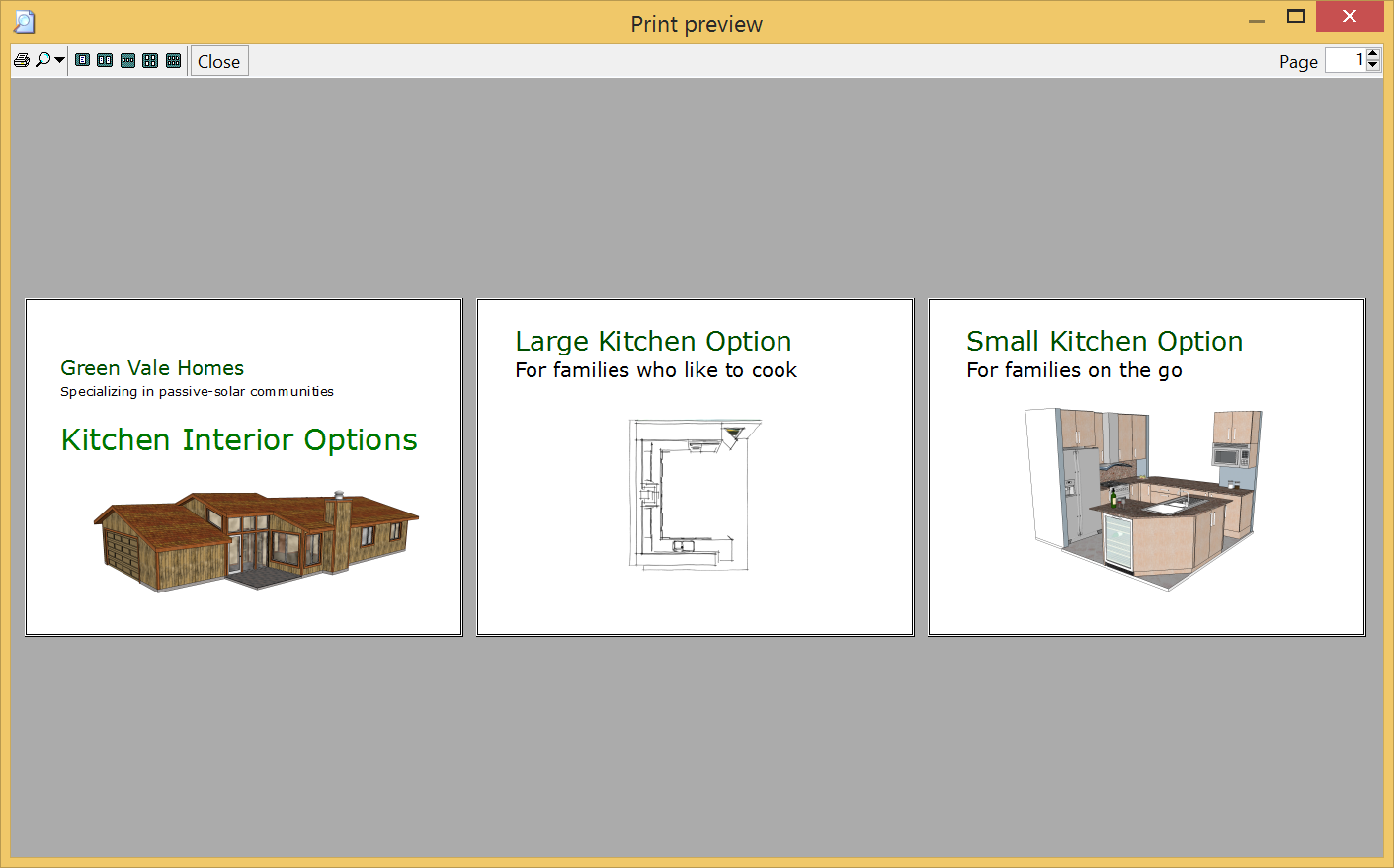
- Preview each page of your document to make sure it will print as you like. Use the Zoom menu in the upper left to zoom in or out of the preview area. Next to the Zoom menu, you can click an icon to select how many pages you see in the preview area. In the upper right, type a page number in the Page box to navigate to a specific page in your document.
- Click the Close button and select File > Print, or click the Print icon in the upper left of the Print Preview dialog box. Either way, the Print dialog box appears, as shown in the following figure.
br>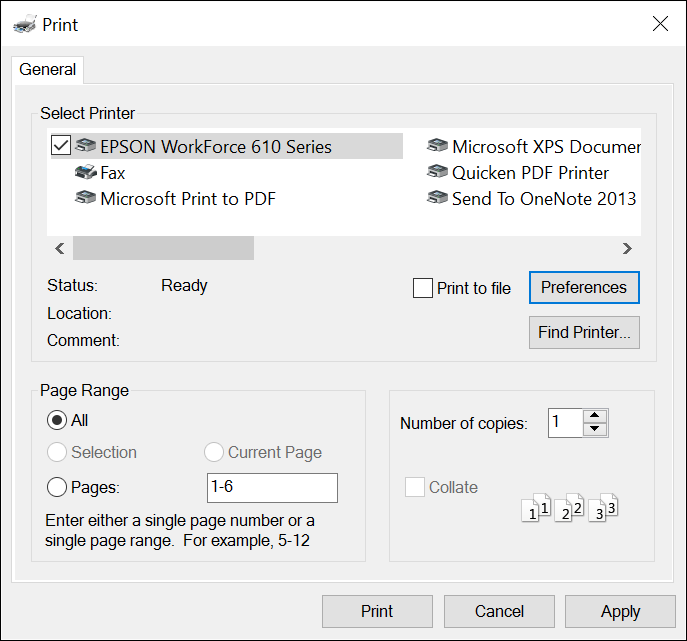
- In the Select Printer list box, select a printer. (If you don't see your desired printer, click the Find Printer button and try to navigate to it in the dialog box that appears.)
- (Optional) Select the Print to File checkbox to create a
.prnfile with formatting and layout data that enables a printer to print the document outside of LayOut. However, note that this file was designed to work with parallel printers and often doesn't work with modern USB or wireless printers. - Click the Preferences button to open the Printing Preferences dialog box. The following figure shows the printing options for the selected EPSON printer, but the options you see vary, depending on the printer you selected in Step 8. Check the documentation for your printer for details about your options. When you're done setting your printer-specific printing preferences, click OK.
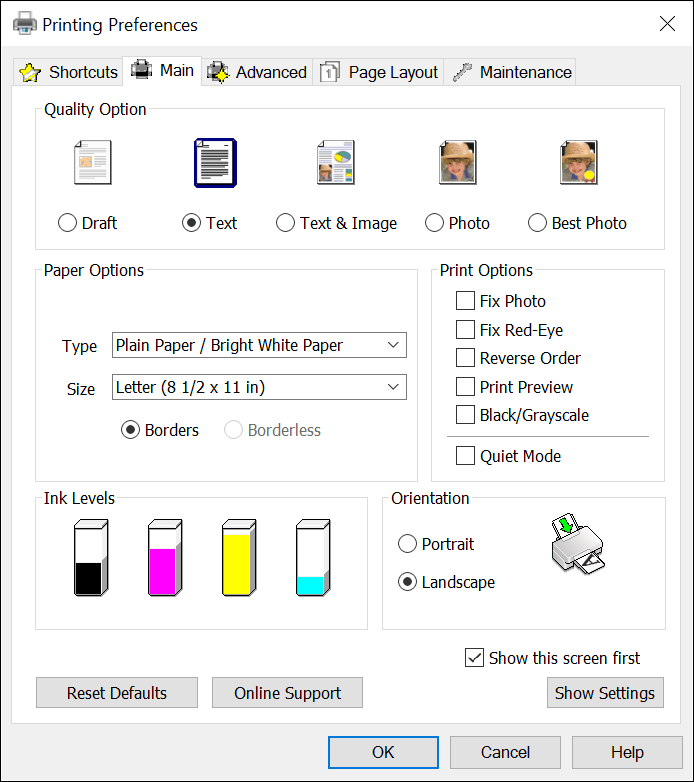
- (Optional) Back in the Print dialog box, the default page range is All. To print a specific page range, select the Pages radio button and enter a page range in the text box.
- (Optional) To print more than one copy of your document, type how many copies you want in the Number of Copies box. Or use the arrows to specify a number. If you print more than one copy, you can choose how your printer collates the copies.
- Click the Print button and (at last!) your document is sent to the printer.
- From the menu bar, select File > Page Setup. A page setup dialog box appears, displaying your page attributes options, as shown in the following figure.

- From the Format For drop-down list, select a printer.
- From the Paper Size drop-down list, select the paper size loaded in your printer.
- (Optional) You likely want to use the default orientation, which reflects the orientation of the template that you selected when you created your document. However, you can select a different option by clicking an Orientation icon for portrait or landscape.
- (Optional) In the Scale box, enter a percentage value to tell your printer how to scale the page in relation to the paper size.
- When you're done choosing page attributes, click OK.
- Select File > Print to open a print dialog box and click the Show Details button in the lower left to expand the available options, as shown in the following figure.

- From the Printer drop-down menu, make sure the printer you want to use is selected.
- (Optional) If you've saved your desired settings as a preset, you can select it from the Presets menu and skip to Step 14. Otherwise, move onto Step 10.
- (Optional) In the Copies box, type the number of copies you want to print.
- (Optional) In the Pages area, choose to print all pages or type a page range in the From/To boxes.
- (Optional) To print more than one document page on each sheet of paper, select the number of document pages from the Pages Per Sheet drop-down list.
- (Optional) To add a border around the margins of your document printout, select the type of border you'd like from the Border drop-down list.
- (Optional) To choose settings specific to your printer, navigate to the various options using the drop-down menu in the center of the dialog box. (In the preceding figure, the LayOut option is selected from this menu.)
- Click the Print button, and your document begins its journey to your printer.
Source: https://help.sketchup.com/en/layout/exporting-or-printing-your-layout-document
0 Response to "Autocad Drawing Wont Export to Pdf"
إرسال تعليق